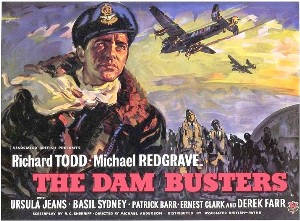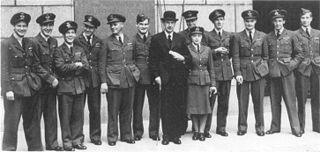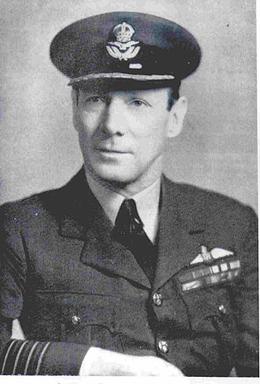
Royal Air Force Kenley, more commonly known as RAF Kenley is a former airfield station of the Royal Flying Corps in the First World War and the RAF in the Second World War. It played a significant role during the Battle of Britain as one of the three RAF stations specifically tasked with the defence of London. It is located near Kenley on the edge of Greater London. The site remains in use with the Ministry of Defence, as Kenley Airfield.

The Dam Busters is a 1955 British epic war film starring Richard Todd and Michael Redgrave. It was directed by Michael Anderson. The film recreates the true story of Operation Chastise when in 1943 the RAF's 617 Squadron attacked the Möhne, Eder, and Sorpe dams in Nazi Germany with Barnes Wallis's bouncing bomb.

Group Captain Sir Douglas Robert Steuart Bader, was a Royal Air Force flying ace during the Second World War. He was credited with 22 aerial victories, four shared victories, six probables, one shared probable and 11 enemy aircraft damaged.

Battle of Britain is a 1969 British war film directed by Guy Hamilton, and produced by Harry Saltzman and S. Benjamin Fisz. The film documents the events of the Battle of Britain. The film drew many respected British actors to accept roles as key figures of the battle, including Laurence Olivier as Air Chief Marshal Sir Hugh Dowding, Trevor Howard as Air Vice-Marshal Keith Park, and Patrick Wymark as Air Vice-Marshal Trafford Leigh-Mallory. It also starred Michael Caine, Christopher Plummer, and Robert Shaw as Squadron Leaders. The script by James Kennaway and Wilfred Greatorex was based on the book The Narrow Margin by Derek Wood and Derek Dempster.
The Big Wing, also known as a Balbo, was an air fighting tactic proposed during the Battle of Britain by 12 Group commander Air Vice-Marshal Trafford Leigh-Mallory and Acting Squadron Leader Douglas Bader. In essence, the tactic involved meeting incoming Luftwaffe bombing raids in strength with a wing-shaped formation of three to five squadrons. In the Battle, this tactic was employed by the Duxford Wing, under Bader's command.

Royal Air Force Coltishall, more commonly known as RAF Coltishall, is a former Royal Air Force station located 10 miles north-north-east of Norwich, in the English county of Norfolk, East Anglia, which operated from 1939 to 2006.

Air Vice Marshal James Edgar Johnson,, DL, nicknamed "Johnnie", was an English Royal Air Force (RAF) pilot and flying ace who flew and fought during the Second World War.

Royal Air Force Tangmere or more simply RAF Tangmere is a former Royal Air Force station located in Tangmere, England, famous for its role in the Battle of Britain.

The Few were the airmen of the Royal Air Force (RAF) and the aviators of the Fleet Air Arm, Royal Navy (RN) who fought the Battle of Britain in the Second World War. The term comes from Winston Churchill's phrase "Never, in the field of human conflict, was so much owed by so many to so few." It also alludes to Shakespeare's famous speech in his play, Henry V: "We few, we happy few, we band of brothers..."
Paul Chester Jerome Brickhill was an Australian fighter pilot, prisoner of war, and author who wrote The Great Escape, The Dam Busters, and Reach for the Sky.

Number 19 Squadron is a squadron of the Royal Air Force. It was the first squadron to operate the Supermarine Spitfire. It currently operates the UK's Control and Reporting Centre from RAF Boulmer. No. 19 Squadron delivers persistent surveillance of UK airspace, and Tactical Control of RAF and NATO aircraft, including the UK's contribution to NATO's Quick Reaction Alert mission.

Wing Commander Brendan Eamonn Fergus Finucane,, known as Paddy Finucane amongst his colleagues, was an Irish Second World War Royal Air Force (RAF) fighter pilot and flying ace—defined as an aviator credited with five or more enemy aircraft destroyed in aerial combat.

Percy Belgrave Lucas,, commonly known as Laddie Lucas, was a Royal Air Force officer, left-handed golfer, author and Member of Parliament (MP).

Harry Melville Arbuthnot Day, was a Royal Marine and later a Royal Air Force pilot during the Second World War. As a prisoner of war, he was senior British officer in a number of camps and a noted escapee.

The finger-four formation is a flight formation used by fighter aircraft. It consists of four aircraft, and four of these formations can be combined into a squadron formation.
No. 242 Squadron RAF was a Royal Air Force (RAF) squadron. It flew in many roles during the First World War, Second World War and Cold War.

The Supermarine Spitfire is a British single-seat fighter aircraft used by the Royal Air Force and other Allied countries before, during, and after World War II. Many variants of the Spitfire were built, from the Mk 1 to the Rolls-Royce Griffon-engined Mk 24 using several wing configurations and guns. It was the only British fighter produced continuously throughout the war. The Spitfire remains popular among enthusiasts; around 70 remain airworthy, and many more are static exhibits in aviation museums throughout the world.
Richard John Cork, was a fighter ace in the Fleet Air Arm of the Royal Navy during the Second World War. Cork served in the Battle of Britain as the wingman for Douglas Bader of No. 242 Squadron RAF. When he returned to the Fleet Air Arm in 1941, Cork served with 880 Naval Air Squadron in the Arctic, Mediterranean and Indian Ocean. It was during Operation Pedestal in 1942 that he became the only Royal Navy pilot to shoot down five aircraft in one day, and was the leading naval ace using the Hawker Hurricane. He was given command of the 15th Naval Fighter Wing aboard HMS Victorious before being killed in a flying accident over Ceylon in 1944.

Percival Stanley Turner, served with the Royal Air Force and the Royal Canadian Air Force during the Second World War. He holds the record of the most combat hours flown of any Canadian pilot.

Wing leader, or wing commander (flying), denotes the tactical commander of a Commonwealth military wing on flying operations. The terms refer to a position, not a rank, although the role was usually taken by an officer ranked wing commander. The position was also distinct from the commanding officer of the wing, generally a higher-ranked officer. The first wing leaders were appointed in 1941, and the position remained in use until the 1960s.

























